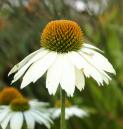Horseradish root is obtained from Cochlearia Armoracia, Linn. (N.O. Cruciferae), a plant indigenous to Eastern Europe, but naturalised and cultivated in Britain. The fresh roots of cultivated plants are alone official. They can be collected all the year round, but are most active in autumn and early spring before the leaves appear. The root is nearly cylindrical in shape, 30 centimetres or more in length, and 12 to 25 millimetres in diameter; externally it is pale yellowish-white, internally almost white, and when scraped or bruised a characteristic pungent odour is developed. The taste is also pungent.
Constituents.—The drug contains the glucoside sinigrin (potassium myronate), which is decomposed in the presence of water by the enzyme myrosin, which is also present in the root. The products of the decomposition are a volatile oil (allyl isothiocyanate), acid potassium sulphate, and dextrose. The root also contains resin, sugar, and starch.
Action and Uses.—Horseradish has the same action as the peppers and more irritant volatile oils, and has been used as a diuretic. It is employed mainly as a condiment for stimulating digestion. Spiritus Armoraciae Compositus is official, and an infusion of the drug may be used as a gargle, or taken as a stimulant.
PREPARATION.
- Spiritus Armoraciae Compositus, B.P.—COMPOUND SPIRIT OF HORSERADISH. Syn.—Aqua Raphani Composita.
- Horseradish root, scraped, 12.5; dried bitter-orange peel, well bruised 12.5; nutmeg, bruised, 0.315; alcohol, 62.5; distilled water, 75. Mix and distil 100. This preparation is used in atonic dyspepsia and to improve the appetite. Dose.—4 to 8 mils (1 to 2 fluid drachms).

